Note: The company that made the shifter I used in my installation is no longer in business. I have left this write-up here since it gives folks an idea of how an electronic push button shifter is adapted to the vehicle and the driver.
As I write this, there is currently another company, RADesigns Products, LLC., that is making a shifting solution that is designed for the AW-4. The adaptation of this shifting solution to a Jeep can be seen in this write-up .
I had read about it on a 4×4 forum a year or two ago when a friend was considering doing an AW-4 tranny swap. A guy had made up a manual shifter for the AW-4, using a rotary switch that allowed selection of 1st, 2nd, 3rd, and Overdrive. From what I read, it had originally been made to accommodate those that didn’t want to deal with wiring in a tranny computer during the AW-4 swap. In other words, you could install an AW-4 and you could skip the TCU. However, you would have to constantly up and downshift the tranny using the knob on the rotary switch. Later, a version for the TJ was produced that let the TCU shift the tranny OR you could manually shift it using the rotary switch.
You are probably wondering why someone would want this when they already have a shifter that will row the AW-4 through its gears. Well….it all comes down to 2nd gear, for the most part.

As you can see on the AW-4’s shifter, it has 2nd gear combined with 1st gear. What this yields is a 1st gear that holds until about 4K RPM before shifting into 2nd gear. If the engine drops in RPM, the tranny will shift back to 1st gear. If you put the shifter in 3rd gear, and you are going down hill, the vehicle will shift from 1st to 2nd to 3rd very easily and you end up in 3rd gear with very little engine braking. You can not keep it in 2nd gear (where the engine braking is much better) unless you shift back into 1st-2nd. When you do, you are back to having the engine run at very high RPM to get 2nd gear.
The AW-4 shifter from AWShifting provides the AW-4 user with a solution…..manual shifting. I recently sent BrettM, who owns AWShifting, an e-mail to inquire about the size of the rotary switch he uses to control the shifter. When he responded, he mentioned he was working on a couple of other versions and had one on the work bench that used push buttons. If I was willing to wait a couple of weeks, he promised to have it ready by the first part of April (I wanted the shifter in and tested by the end of April for the upcoming Moab trip). I told him I would wait a bit and see how the push button version turned out.
As I write this, BrettM is not completely sure that he is going to release this version (push button gear selection) for sale. He told me that at this point, I have the prototype and that may be the only one. Hopefully that won’t be and he’ll change his mind and offer this version for sale.
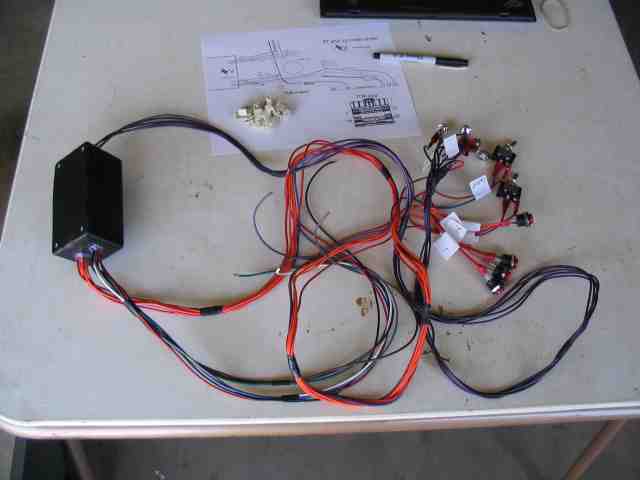
With the exception of the little white tags on some of the wires, this is what the shifter looked like when I got it. Basically, it consists of a control box (on the left), a 2′ long section of wiring that splices into your existing AW-4 TCU harness, and two other wire bundles. One of them is for the 4 LED indicators while the other attaches the 4 pushbutton switches and the two toggle switches to the control box.
As most TJ owners know, there’s not a lot of dash space available in the vehicle. So my first job was trying to figure out just where I was going to mount everything. BrettM had constructed it so that the switches and LED indicators could be mounted separately from each other (good idea). All I had to do was figure out just where it was I would put everything. After 30 minutes, I finally figured out that if I was going to get the shifter installed this weekend, I had better come up with an idea. (did I mention I was having a problem trying to figure out where it was going?)
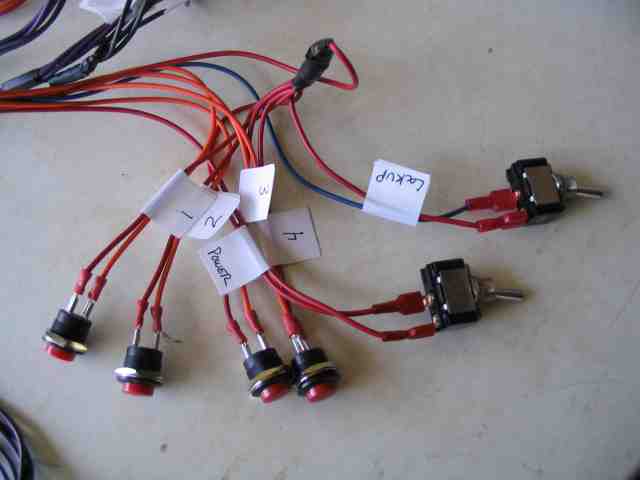
The shifter uses two toggle switches and four momentary push buttons. One toggle switch selects the shifter’s mode of operation, Auto or Manual. In Automatic mode, the TCU functions normally and controls the tranny. In Manual mode, you select the forward gears by using the pushbuttons. The other toggle switch is used to lockup the torque converter.
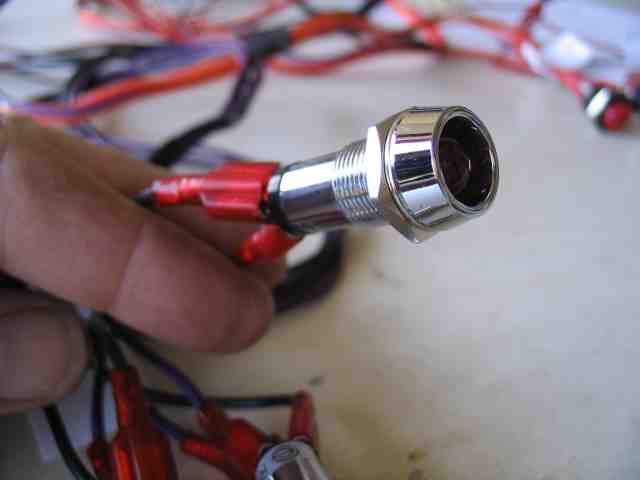
BrettM included some nice red LEDs in the shifter. They are pretty high intensity and if I’m not mistaken, they are the same brand/model used in my dash mounted winch controller. I should also mention that the switches also appear to be of good quality.
So….I spent some more time trying to figure out where I was going to mount everything (again). I finally decided to make a few changes to the existing components and locate the switches and LEDs in a small project box. Since this is a prototype unit, I decided I could always remount it at a later date if I didn’t like my decision. (Hey, it’s my Jeep!)
I made a trip to the local Radio Shack store and picked up 4 new LEDs. They are a bit smaller (and not as bright). The part number is 276-270. Like those supplied by BrettM, these LEDs can be connected to a 12V source without damage. I also purchased a small project box, part number 270-1803. The dimensions are 5″ x 2.5″ x 2″.
AW-4 Manual Shifter

I quickly constructed a paper template, making sure I had sufficient space for all 6 switches and the 4 new LED assemblies. I taped the paper template to the lid and drilled all of the holes with an 1/8″ drill bit. The four holes for the LEDs were increased to 9/32″. You can see one of the new LEDs sitting in its hole.
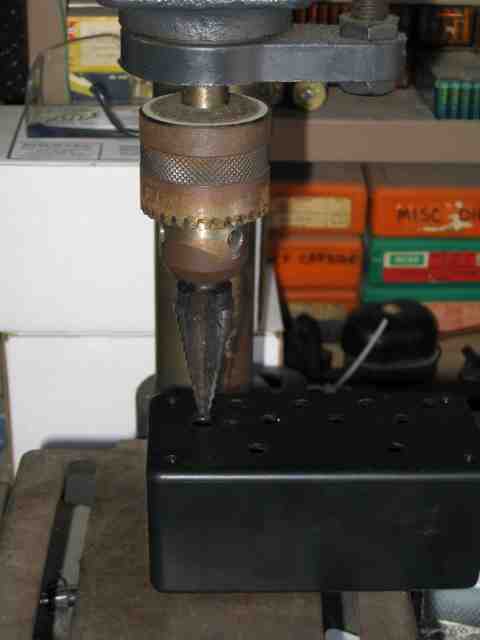
The hole for the pushbutton switches needed to be about 3/4″. I didn’t have a regular drill bit that size but I did have one of those step drills. I put it in my drill press and carefully enlarged the four pushbutton holes. While I had the drill press running, I also drilled the two holes for the toggle switches.

The top of the project box, all switches mounted and the LEDs installed. If you are not into plastic panels, the box also comes with an aluminum panel. At this point, the components (switches and LEDs) can be connected back to the harness. Prior to removing them from the wiring harness, I tagged all of the wires to make it easy to reconnect them once everything was mounted. I drilled a large hole in the end of the project box to bring in the wires.
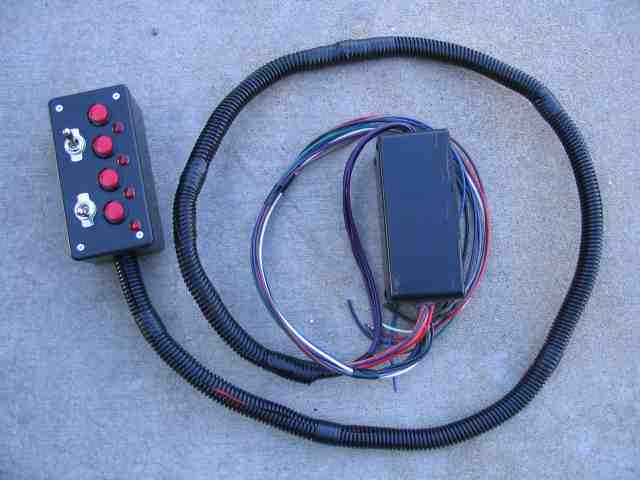
I keep a stash of wire loom in my electrical odds and ends box. I bundled the two wire groups (for the switches and the LEDs) together in a section of plastic loom and tape it every 10″ or there about.
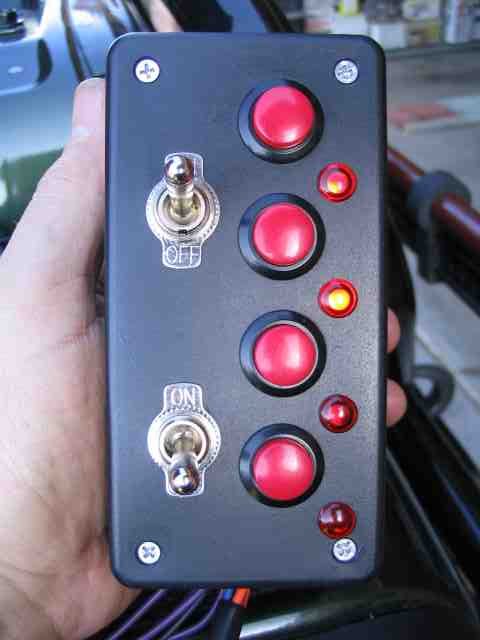
All buttoned up and a couple of LEDs lit (just to make sure my wiring was good). I was thinking of getting one of those red flip open covers for the main switch. That should prevent it from being accidentally turned on.
AW-4 Manual Shifter
The modifications I wanted to make to the shifter had been completed. For a quick checkout, I attached the two power leads (+12V and ground) to the battery. I was able to illuminate the four LEDs as I pushed each of the pushbuttons. It looked good at this point and I called it quits for the day. Time to get some dinner and catch up some e-mail at the computer.
The following day, after helping my buddy install his new 30 spline outer shafts and unit bearings in his Rubicon, I got back to the job of installing the shifter. It was time to splice the wiring harness for the manual shifter into the TCU’s wiring harness.
BrettM included a wiring diagram in an e-mail along with written instructions. Realizing that this is a prototype, I wasn’t too concerned with the written instructions. One look at the wiring diagram showed me everything I needed to know. It was going to be a straight forward wiring job. After doing the entire AW-4 TCU wiring myself, this was but a small part of it.
BrettM provided quality wire taps in the kit. Since I prefer a good solder job and/or crimped connections with heat shrink over the connection, I put the wire taps aside for one of those “to be used on the trail in case of an emergency” situations. I won’t say that I don’t have one or two wire taps under the dash (because I do), its just that they are not powering a vital component….and for me, the solenoid connections to my tranny are considered vital.
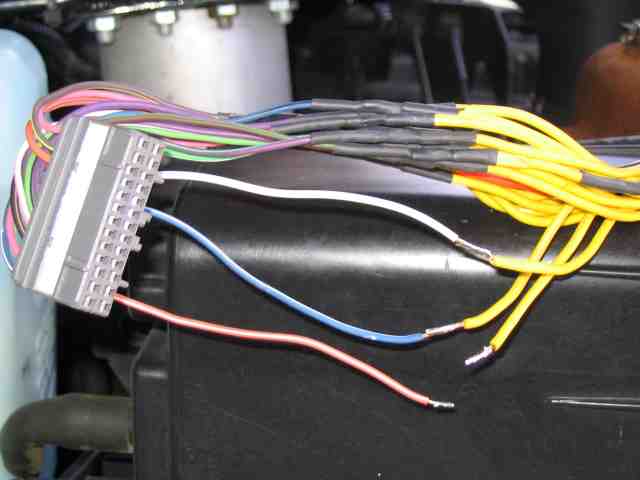
If you are reading this write-up, I am hoping it is because you either have an AW-4 in your Jeep or you are getting ready to do an AW-4 swap. If it is because of an upcoming swap, then you might want to consider integrating the AWShifter into your work plan. Doing so will save yourself some time and effort as you won’t have to take apart your high quality custom TCU wiring harness that goes along with the AW-4 swap (assuming you are installing the TCU).

Since I so hate working under the dash on a wiring project, I disconnected the TCU’s harness from the TCU and pushed it back through the firewall. I then fished the AWShifter wires through the same hole. This allowed me to work on the wiring outside of the vehicle….or maybe I should say standing next to it.
I carefully cut the heat shrink from the TCU wires that were called out in BrettM’s wiring diagram. I unsoldered the previously spliced connections so I can splice them again to include the AWShifter. Before I am done with this entire AW-4 project, I think I am going to invest in a heat shrink company so I can get it at a discount.
I finished the last of the connections (there are 8 of them) and replaced the wire loom and electrical tape that I had removed to gain access to the wires. The wiring harness, now a little fatter than before, was gently pushed back through the firewall. Under the dash, I reconnected the wiring harness to the TCU. With junk still littering the floor of the TJ, I had to see if it was working. I hopped into the driver’s seat and backed it out of the driveway.
I slipped the TJ’s shifter into “D” and flipped the power switch on the AWShifter. I was met with all 4 LEDs lit up (which is just as it should be). Leaving it in Overdrive, I nudged the gas pedal a little bit. Engine RPM went up but I just barely moved….PERFECT! I would have been very disappointed if I accelerated away. The torque converter obviously had to slip a whole lot, which was expected. I pushed the 1st gear button and was promptly greeted with the same response I would have gotten prior to the AWShifter being installed. I took it a couple of blocks down the street to make sure everything shifted properly and the torque converter locked up. All was good!
Back in the driveway, I was faced with where to put my switch and LED box. Did I mention I never really did come up with a good idea? I still hadn’t.
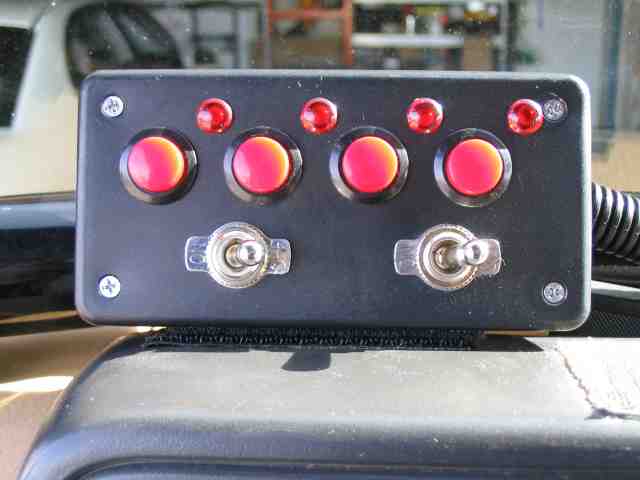
I opted for the top of the dash, for now anyway. It will probably stay there until I get back from our week in Moab and then I’ll take another stab at it. I used some extra wide Velcro to hold the box in place (along with a couple of cable ties on the dash bar).
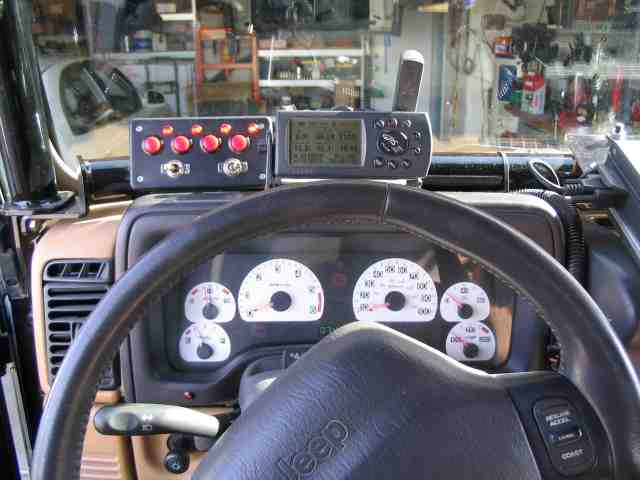
As I write this tonight, I just got back from taking my daughter to her night job. She thought the manual shifter was pretty cool. It was my first chance to drive with this at night. The LEDs were bright but not blinding, so that made me happy. Where I have them located, it is perfect for day time driving (bright sun) but possibly a little distracting at night. Granted, I’ve no need for it except when I am off-road, and that won’t be all that often as I don’t do night runs that much any more.
My next attempt at mounting the switches and LEDs will to separate them. The LEDs will probably find some spot where I can see them in my normal field of view for driving and the switches will hopefully find a spot in the vicinity of the center console.
I’m happy to say that the AWShifter appears to be everything I heard it was. I’ve not tried it off-road yet, but I see no reason why it won’t perform just as I expect. I put an update here after I’ve had a chance to try it on a couple of trails. It will certainly get a workout in Moab, that I am very sure of. Many thanks to BrettM for getting me his push button AWShifter in the promised time frame. It lets me scratch one more thing off of my to-do list before I leave for Moab. Thanks Brett!
Good trails to you and remember to TREADLightly!
AW-4 Manual Shifter
Version2
This is Version 2 of the AW-4 Manual Shifter….or at least it is version 2 for me. BrettM at AWShifting stepped up to the plate with a new design when I informed him that his previous shifter was experiencing some problems in my TJ. I was basically running the prototype and so the fact that it had a minor problem wasn’t a total surprise. I had helped BobP install his AW-4 shifter (same model used in my first install) and his displayed the same problems right out of the box. It took BerttM a little time to iron the kinks out of the new shifter design, but I think the wait was worth it.
The new shifter resides in a box similar to the version 1 except that it is about half as deep. The new shifter uses a programmable interface chip instead of the plethora of sequencing relays used in version 1.
The interface for version 2, into the AW-4 tranny computer, is identical to version 1. Same wire count and wire colors are used in the new version. This made for a relatively easy installation for me. I cut the existing wiring off at an appropriate spot and then soldered the new wires (using heat shrink for insulation) into version 1’s wire harness. In doing it this way, I didn’t have to deal with removing and reinstalling the wires that I have soldered into place near the AW-4 tranny computer’s interface plug.
With the vehicle side of the shifter’s wiring harness taken care of, it was time to turn my attention to the shifting controls.
The new shifter was designed to operate with two shifting inputs, one for up shifting and the other for down shifting. They share a common +12V power line and thus have only two other wires going into the controller.
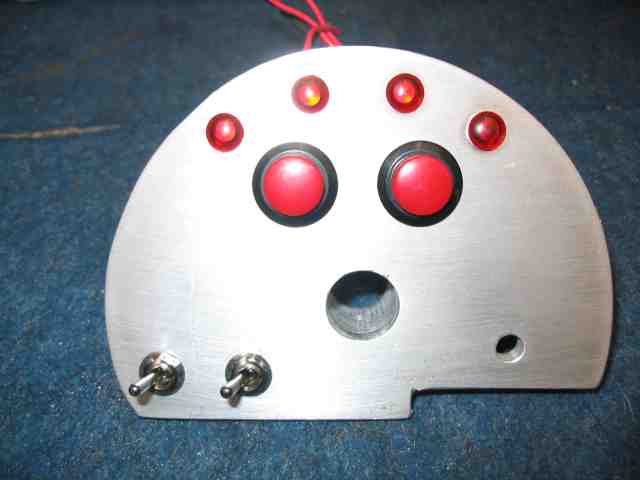
I used a pair (the two large red buttons) of normally open switches with momentary contacts. The buttons are about 1″ in size and so make it pretty easy to shift without looking.
The controls are mounted on a piece of 1/4″ aluminum plate. The large hole in the plate is sized to just fit the console shifter. A 1″ thick collar with a matching hole, is TIG welded to the plate. I tapped the collar for a couple of 10×32 set screws. This securely holds the plate in place on the tranny shifter.
The two small toggle switches, lower left area, turn the AW-4 shifter on/off and lock up the torque converter. A pair of wires connects both of the toggle switches to the shifter box.
The LEDS were salvaged from my version 1 control box (just like the red switches). BrettM changed the configuration for their wiring but it wasn’t a big issue to switch it around. They now use a common +12V line and the shifter box applies a ground on a wire that goes to each of the LED’s negative power leads. As before, the LEDs light up as you upshift and extinguish as you down shift. I have mine wired so that 1st gear is on the left and overdrive is on the right.
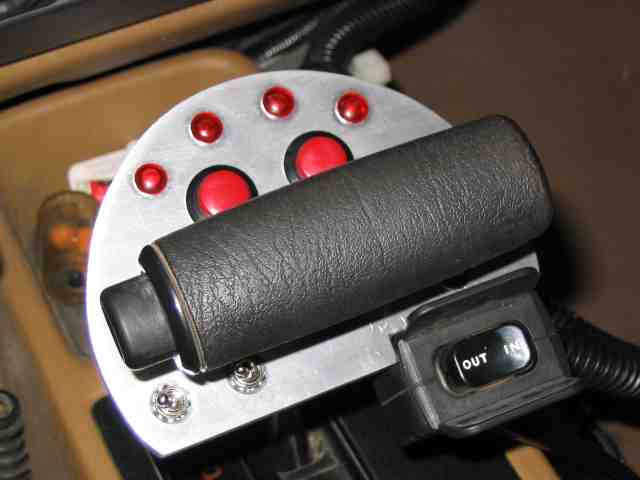
A pic of my controls mounted on the tranny shifter. I attached the suck-down winch switch to the lower right section of the plate. It’s a handy spot for the control switch.
Much like the control box I had for the version 1 shifter, this control plate is still a work in progress. It will most likely get modified (or not) if I feel like putting some more effort into it. I’m still considering reducing the plate size and mounting some LEDs up near the instrument cluster area. That would make it easy to see the selected gear without having to look down at the existing controls. Maybe it will happen, maybe it won’t. It will depend on how this one works out.
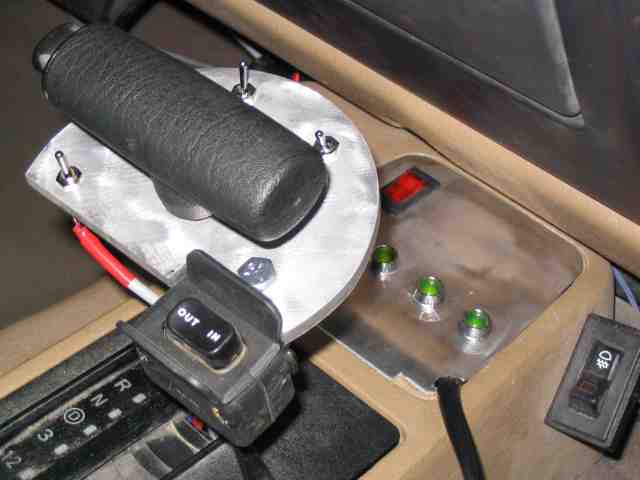
I did the vehicle interface wiring on BobP’s version 2 shifter. He made a control plate when I made mine. Bob mounted his LEDs in the coin tray (at the front end of the center console) and used a momentary ON-OFF-ON toggle switch to gears (it’s the single toggle located in the lower left corner of the plate). The other two toggle switches are the power and torque converter lockup.
Well, that is about it for the version 2 installation. It was straight forward and recyling the wiring and parts from the version AW4 shifter made it pretty easy.
If you have done an AW-4 swap and you haven’t installed a manual shifter yet, I strongly urge you to give it a try. Being able to hold 1st or 2nd gear, at will, while off-road, is the best feature this mod brings. Being able to “row” through the gears, so to speak, on the street or highway is just an added benefit.
AW-4 Manual Shifter
(more changes)
Update: 10/21/2006
The shifter has worked very well for the past couple of months. It was used quite a bit on the Pyeatt Draw trail that Donna and I ran just last week.
About 10 minutes after getting version 2 installed, I decided I was not satisfied with the shifter controls as they were mounted. I didn’t like looking down to see how many LEDs were lit. Being located somewhere in my field of vision when I was looking at the trail would be a better setup. I also decided that the physical shape of the control plate needed some attention as well. I hate to use the words “ergonomically correct” but that pretty much describes it. The ergonomic changes twill happen later on as I need to cut and weld the plate and I don’t have the necessary tools for that in my garage. However, I did get the LEDs relocated today and this part of the write-up will cover that.
As usual, I spent too much time trying to figure out where the LEDs should take up residence. After kicking around some ideas with BobP, I decided on the dash bar. Mounting them there would be them right in front of me and very easy to see.
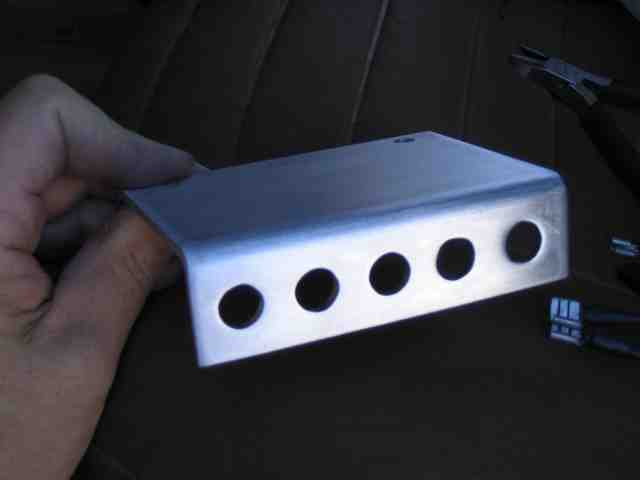
After determining how much space my LEDs would need, I selected a piece of scrap 1/8″ aluminum plate for the LED mount. After some cutting, drilling, and bending, I put a brushed finish on it using some 100 grit sandpaper. Not sure if I’ll powder coat it or not…..time will tell. The front of the mounting plate has a 90 degree bend while the rear edge of the plate as a 45 degree lip. The 45 degree lip looks better as the plate kind of wraps around the bar just a bit.
Bob and I folded the windshield down so I could drill a pair of mounting holes in the dash bar. Using a 1/4″x20 tap, I threaded the dash bar holes to make it easier when it came time to mount the plate.
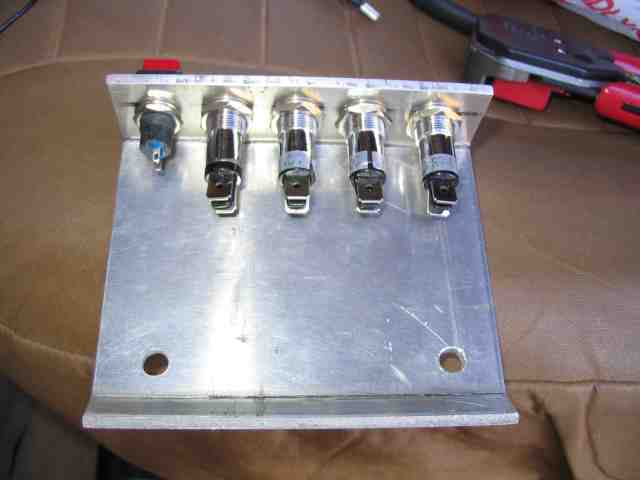
The 4 LEDs were mounted on the plate and the 5th hole received a small push on/off single pole switch. These LEDs are brighter than those I had mounted down on the shifter. Since these are directly in front of me, I decided to include the switch so that I could turn off the LED lights if they proved too bright during a night run. (not sure if they would but having the switch there guarantees there won’t be an issue)

The shifter switches the ground lead to turn on and off the LEDs so each LED has one wire going to it from the shifter box. The +12V lead is daisy chained from the power switch (on the left) to each of the 4 LEDs on the plate. This makes for a simple and easy way to power each of the LEDs.
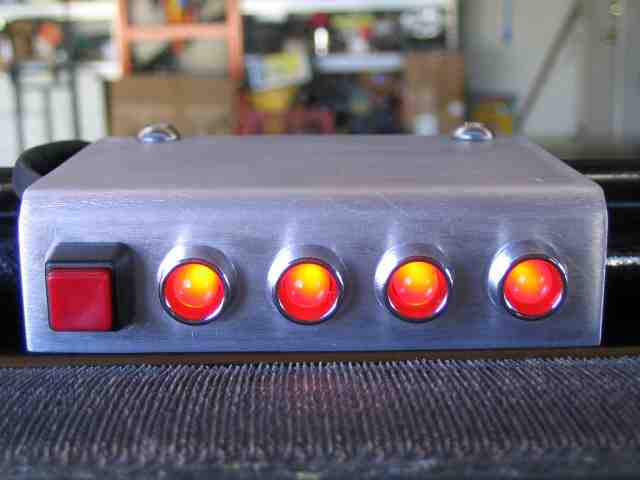
Each of the 4 ground leads from the shifter were attached to the appropriate LED. I used a couple of button Allen head screws to attach the plate to the dash bar. The cable was routed down along the defroster vent and under the dash to the shifter.
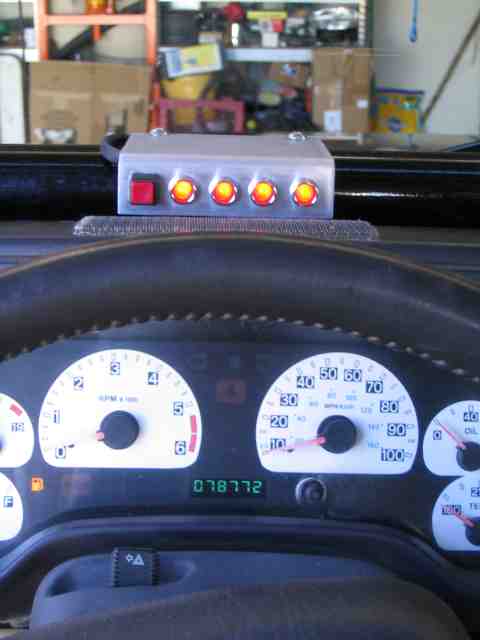
The LEDs as seen from the driver’s seat. There must be a reason that red LEDs show up as orange when the photo is taken with a digital camera. My LED trail lights show orange too.
I’m satisfied with the new location for the LEDs. They are not blocking my view of anything but yet are right there in front of me. I like this new setup.
Next comes the plate on the tranny shifter….a bit of an ergonomic overhaul should have it feeling just right.
Update: 11/12/2006
I had a chance today to address the plate on the tranny shifter. The first plate I made with the control switches mounted on it ended up larger than I originally planned and now that the shift indicator LEDs are no longer on the plate, it could certainly stand to lose some of the surface area.
I penciled in a rough sketch of what I wanted and started grinding away areas of the plate. A little hear, a little there….I wasn’t worried about it being symmetrical as I decided this was more about fit and function and less about looks. However, the end result looked pretty good, in my opinion…..at least better than the first attempt.
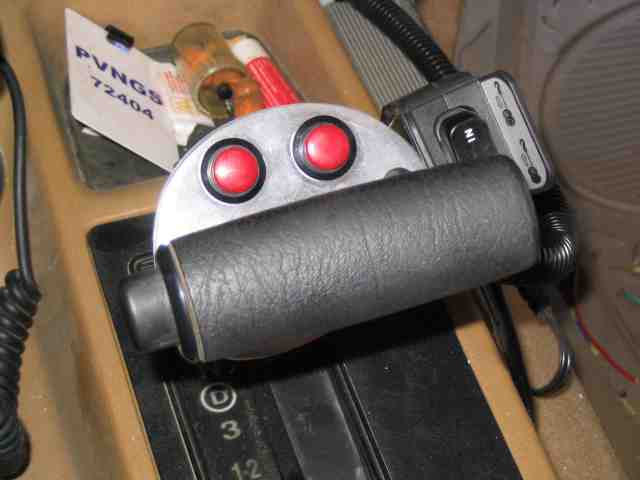
As seen from the driver’s seat, the switch plate is now a fair amount smaller than before. In fact, it is a LOT smaller. Click here for a comparison of how it was.
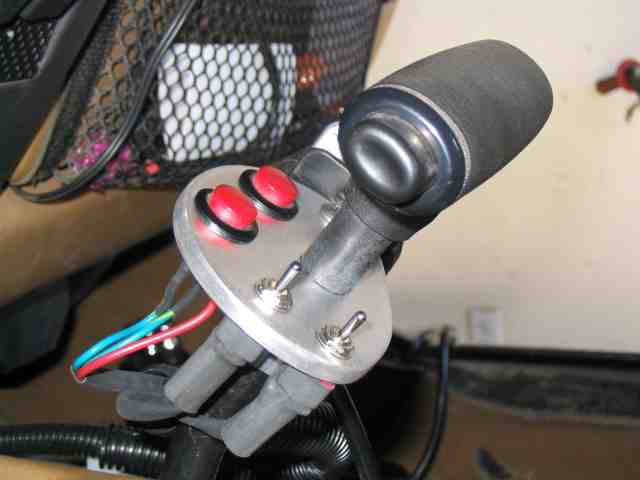
A view from the driver’s side of the console. The two toggle switches were repositioned (one remained in the original mounting hole) to make use of some of the real estate that was directly below the shifter handle. With the LEDs removed, about 1/2″ was trimmed from the leading edge of the plate as well as the sides. The suck down winch control switch remained attached to the plate but it was moved further forward and is now easier to manipulate. The clearance issue that resulted from the plate hitting the console when pulled down into 1-2 gear range is no longer an issue. I positioned the plate further down the shifter shaft which makes it easier to manage all of the switches (no more finger cramping).
Easy enough to do….just needed an hour or two to unsolder the wiring, remove the switches, grind and sand the plate to size, drill a couple of new holes, and put it all back together. Piece of cake!
Good trails and remember to TREADLightly!
